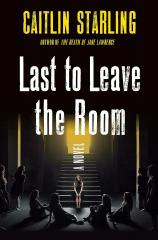Last to Leave the Room
Review
Last to Leave the Room
Some works of horror defy easy categorization, and that is certainly the case with LAST TO LEAVE THE ROOM. Caitlin Starling doesn’t simply rehash old horror tropes and gags but plays with the genre. She creates something more akin to a simmering speculative thriller with a creeping sense of dread and rooted in some expected but compelling doppelgänger themes.
Dr. Tamsin Rivers is a tough-as-nails scientist working as a researcher for a communication corporation in San Siroco. She and her team have detected a downward movement, or stretching, in the underground labs where much of Myrica Dynamic’s work takes place. The cause of this subsidence is unclear, and the measurements seem implausible and unreal. But, as she starts digging deeper into the calculations, her world begins to turn upside down. She is being closely watched by the enigmatic Mx. Woodfield, a sort of digital muscle hired by Myrica Dynamic to keep her in line.
"LAST TO LEAVE THE ROOM is the story of a door, a doppelgänger and a sinking city, but mostly it is about the ways in which identity is more fragile than we realize."
While Woodfield seems to know Tamsin’s movements throughout the day, both at work and at home, they seem unaware that the subsidence is happening in her own basement as well. Tamsin’s work on the subsidence veers into obsession when she notices a door in her basement that was not there before. The door is disconcerting enough, but when it finally opens, something or someone walks through.
It appears to be Tamsin, or another version of her. This Tamsin seems naive and vulnerable, the opposite of Dr. Rivers in most ways. Tamsin is unsure if this doppelgänger is human, where it came from and why it has arrived. But she also quickly realizes that it is smart and canny. Calling it “Prime” (but not using the pronoun “she”), Tamsin begins to experiment and teach. Prime is a fast learner and shares much knowledge with the original Tamsin.
Then, over time, as the subsidence becomes a greater problem, and as Woodfield notices Tamsin growing more erratic and less reliable, Tamsin and Prime find themselves in different relative positions altogether. Now Prime is in control, and Tamsin is reduced to a helpless, confused and wounded figure. As the ground seems to be literally slipping, so does Tamsin’s grasp of reality and power over her self. The fight to regain control will be a terrifying and bloody one.
LAST TO LEAVE THE ROOM is the story of a door, a doppelgänger and a sinking city, but mostly it is about the ways in which identity is more fragile than we realize. Starling’s prose is clean and her story interesting, but the pacing is uneven at times, and the mechanisms of the world and the plot are not always clear. Overall, though, she gives readers complex characters in a complicated and intriguing philosophical tale.
Reviewed by Sarah Rachel Egelman on October 20, 2023
Last to Leave the Room
- Publication Date: October 10, 2023
- Genres: Fiction, Horror, Supernatural Thriller, Suspense, Thriller
- Hardcover: 320 pages
- Publisher: St. Martin's Press
- ISBN-10: 1250282616
- ISBN-13: 9781250282613




